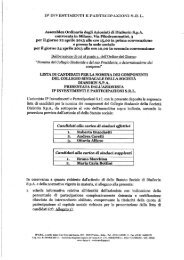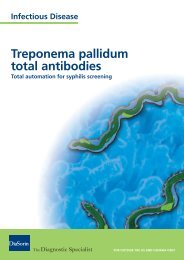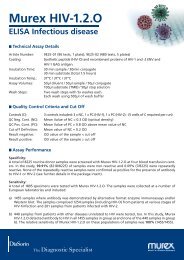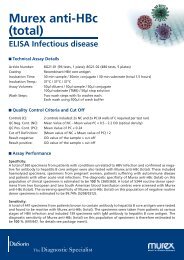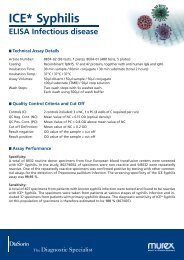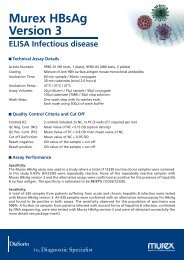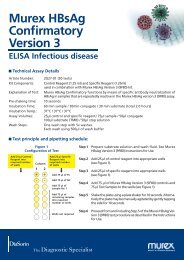Syphilis Booklet - DiaSorin
Syphilis Booklet - DiaSorin
Syphilis Booklet - DiaSorin
Create successful ePaper yourself
Turn your PDF publications into a flip-book with our unique Google optimized e-Paper software.
1. Microorganism and disease<br />
<strong>Syphilis</strong> is a systemic infectious disease caused<br />
by the Treponema pallidum subspecies<br />
pallidum. It is generally acquired by direct sexual<br />
contact and features treponemes-containing<br />
lesions. The infection can also affect a foetus if<br />
the pathogen crosses the placental barrier. The<br />
only known hosts are human beings.<br />
1.1 The microorganism<br />
Treponema pallidum belongs to the genus<br />
Treponema, Spirochaetales order and<br />
Spirochaetaceae family, together with Borrelia<br />
and Leptospira.<br />
This genus includes three other human<br />
pathogenic subspecies and at least six<br />
saprophytic bacteria present in normal<br />
digestive and genital tract flora and the oral<br />
cavity. The pathogenic subspecies are pallidum,<br />
which causes venereal syphilis, endemicum,<br />
responsible for non-venereal endemic syphilis<br />
also known as bejel and pertenue, which<br />
produces yaws. Due to insufficient genetic<br />
information, another pathogenic treponeme,<br />
Treponema carateum, which causes pinta, has<br />
not yet been formally classified as a subspecies<br />
(Cf. Table 1). 1 They all present higher than 95%<br />
genetic homology and are morphologically<br />
indistinguishable from each other. 1–4<br />
T. pallidum has a thin, regular helical shape<br />
with no terminal hook. Its length ranges from<br />
6 to 20 µm and its diameter from 0.10 to 0.20<br />
µm. Its small size makes it invisible to light<br />
1 µm<br />
Picture 1: T. pallidum Nichols cell negative staining<br />
(Electron microscopy, X 2,500 Bar, 1 µm).<br />
From Dettori G, Amalfitano G, Polonelli L et al. Electron<br />
microscopy studies of human intestinal spirochetes. Eur J<br />
Epidemiol 1987;3:187-95. Authorised reproduction<br />
microscopy, but it can be identified with<br />
phase-contrast microscopy or staining<br />
methods, which increase bacterial thickness 1,3<br />
(Cf. Picture 1).<br />
Biochemically, T. pallidum consists of 70%<br />
proteins, 20% mainly high cardiolipid-content<br />
phospholipids and 7% carbohydrates.<br />
Metabolically, it is a low-activity microorganism,<br />
which uses enzymatic host mechanisms.<br />
The bacterium can only produce ATP by<br />
glycolysis. Given this low energy production,<br />
its tissue generation time is extremely long,<br />
from 30 up to 33 hours. T. pallidum cannot be<br />
cultivated in the conventional sense but can<br />
be reproduced in specific tissues, such as<br />
mouse testes by using the Nichols strain. It is<br />
thermolabile; some of its enzymes cannot<br />
withstand temperatures other than those of<br />
Table 1: Pathology produced by pathogenic treponemes<br />
subsp. pallidum<br />
subsp. pertenue<br />
subsp. endemicum<br />
subsp. carateum<br />
Disease<br />
Infection<br />
Transmission<br />
Distribution<br />
Age<br />
Lesion<br />
<strong>Syphilis</strong><br />
Systemic<br />
Sexual<br />
Congenital<br />
Worldwide<br />
Sexual<br />
activity<br />
Syphiloma<br />
Yaws<br />
Cutaneous<br />
Not sexual<br />
Tropical<br />
All<br />
Papilloma on<br />
exposed skin<br />
Bejel<br />
Cutaneous<br />
Not sexual<br />
Deserts<br />
All<br />
Dermal, perioral<br />
Pinta<br />
Cutaneous<br />
Not sexual<br />
Deserts<br />
All<br />
Dermal on dorsum<br />
of the foot<br />
3



